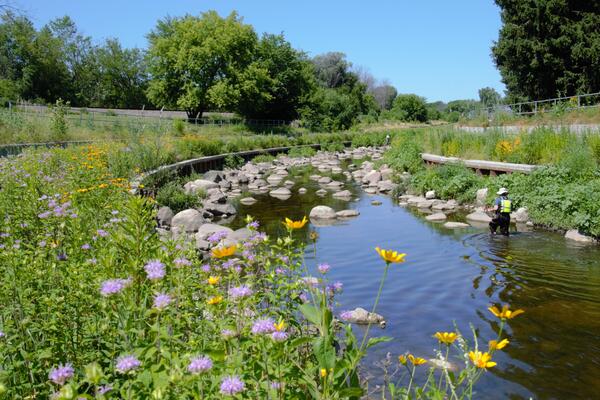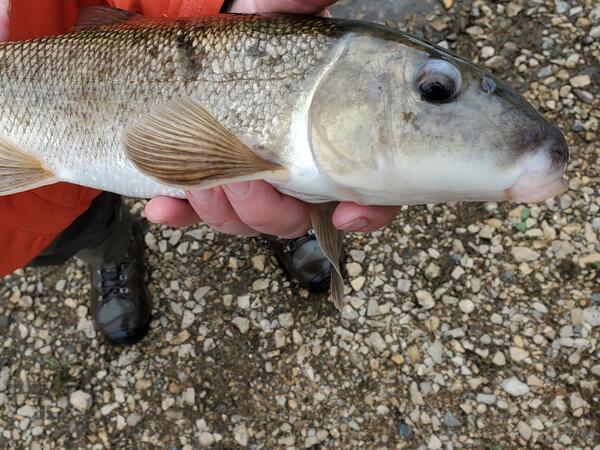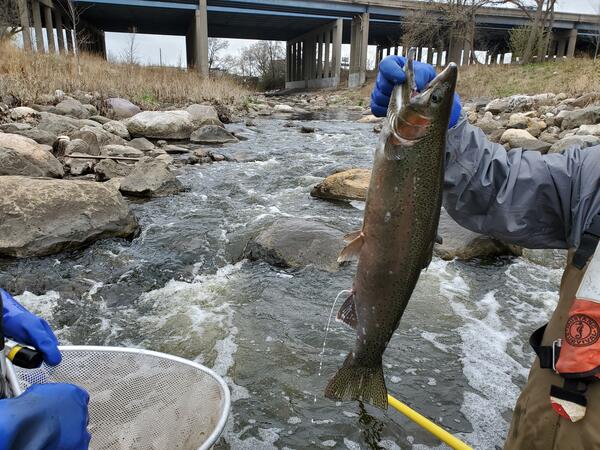Physical Scientist James Romano (UMid WSC, left) and Field Assistant Justin Peschman (UMid WSC, right) collect a sediment core from the Scuppernong River near Palmyra, Wisconsin. https://waterdata.usgs.gov/monitoring-location/05426400
Hayley T Olds
Hayley Olds is a Hydrologist with the Upper Midwest Water Science Center in Wisconsin, where she has worked since 2012.
Hayley Olds is stationed in Milwaukee, Wisconsin. Her research has focused on freshwater quality assessments using both freshwater organisms and molecular source tracking. Hayley has experience with monitoring harmful algal blooms (HABs) composition, toxicity, and spatial extent using low-cost sampling techiques such as Solid Phase Adsorption Toxin Tracking (SPATT) technology throughout the Upper Midwest and Northeast regions, and nation-wide at National Parks throughout the country. Hayley also has experience in assessing benthic invertebrate, phytoplankton, and zooplankton communities, as well as sediment contamination and toxicity, in rivers and streams throughout Wisconsin, including several of Wisconsin’s Lake Michigan Areas of Concern. Over her career, Hayley has been involved in collecting and analyzing ecological data, including algae, invertebrates, fish, sediment, and surveying habitat at a local scale in southeastern Wisconsin's tributaries to Lake Michigan, as well as nationally in the Pacific Northwest, Northeast, and California regions.
Professional Experience
2015 - Present, Hydrologist, USGS Upper Midwest Water Science Center
2012 - 2015, Hydrologic Technician, USGS Upper Midwest Water Science Center
Education and Certifications
2015, M.S. in Freshwater Sciences and Technology – University of Wisconsin-Milwaukee, Milwaukee, Wisconsin, Thesis: “The Identification and Quantification of Sewage Contamination in the Milwaukee Estu
2013, B.S. in Water Resources – University of Wisconsin-Stevens Point, Stevens Point, Wisconsin.
Affiliations and Memberships*
Wisconsin Section of the American Water Resources Association
- 2012 - Present, Member
- 2019 - Present, Planning Committee Communications Chair
Science and Products
Integrated Ecosystems Studies Team
MMSD Watercourse Corridor Study: Ecological Assessments and Trends
Select optical signals from water samples collected on the Menomonee River, Underwood Creek, and Jones Island Water Reclamation Facility from 2017-2019, and time-series optical sensor and one-hour mean streamflow data from the Menomonee River 2017-2018
Polychlorinated biphenyl (PCB) data from instream water and sediment passive samplers, stream bank sediment, and catch basin sediment in the Clinton River Area of Concern, Michigan, USA, 2019
Bottom sediment chemical data at rivermouths and harbors along western Lake Michigan, USA, 2016
Rapid assessment test strip data for determining cyanotoxin presence in algal blooms, Kabetogama Lake, northern Minnesota, 2017-2018
Aquatic community and environmental data for 14 rivers and streams in the Milwaukee Metropolitan Sewerage District Planning Area, 2004-13
Phytoplankton enumeration and identification from a recurring algal bloom location in Sullivan Bay, Kabetogama Lake, northern Minnesota, 2016
Human-associated indicator bacteria and human specific virus loads, sample volumes, and drainage areas for six Menomonee River Watershed sampling locations
Benthos and Plankton data for Waukegan Harbor Area of Concern, Illinois, and Burns Harbor-Port of Indiana Non-Area of Concern, Indiana, in 2015

Physical Scientist James Romano (UMid WSC, left) and Field Assistant Justin Peschman (UMid WSC, right) collect a sediment core from the Scuppernong River near Palmyra, Wisconsin. https://waterdata.usgs.gov/monitoring-location/05426400

Biologist Pat Perner (USGS Upper Midwest Environmental Science Center, left) and Physical Scientist James Romano (UMid WSC, right) collect a sediment core from the Mukwonago River at Mukwonago, Wisconsin. https://waterdata.usgs.gov/monitoring-location/05544200/
Biologist Pat Perner (USGS Upper Midwest Environmental Science Center, left) and Physical Scientist James Romano (UMid WSC, right) collect a sediment core from the Mukwonago River at Mukwonago, Wisconsin. https://waterdata.usgs.gov/monitoring-location/05544200/

Two scientists collect a sediment core from the Root River at Grange Avenue in Greenfield, Wisconsin
linkBiologist Pat Perner (USGS Upper Midwest Environmental Science Center, left) and Field Assistant Justin Peschman (UMid WSC, right) collect a sediment core from the Root River at Grange Avenue in Greenfield, Wisconsin. https://waterdata.usgs.gov/monitoring-location/04087214/
Two scientists collect a sediment core from the Root River at Grange Avenue in Greenfield, Wisconsin
linkBiologist Pat Perner (USGS Upper Midwest Environmental Science Center, left) and Field Assistant Justin Peschman (UMid WSC, right) collect a sediment core from the Root River at Grange Avenue in Greenfield, Wisconsin. https://waterdata.usgs.gov/monitoring-location/04087214/

Field Assistant Justin Peschman (UMid WSC) filters a water sample for nutrient analysis at Mukwonago River at Mukwonago, Wisconsin. https://waterdata.usgs.gov/monitoring-location/05544200/
Field Assistant Justin Peschman (UMid WSC) filters a water sample for nutrient analysis at Mukwonago River at Mukwonago, Wisconsin. https://waterdata.usgs.gov/monitoring-location/05544200/

Habitat sampling at a restored reach at Underwood Creek at Wauwatosa, Wisconsin. https://waterdata.usgs.gov/monitoring-location/04087088/
Habitat sampling at a restored reach at Underwood Creek at Wauwatosa, Wisconsin. https://waterdata.usgs.gov/monitoring-location/04087088/

A restored section of Underwood Creek at Wauwatosa, Wisconsin. https://waterdata.usgs.gov/monitoring-location/04087088/
A restored section of Underwood Creek at Wauwatosa, Wisconsin. https://waterdata.usgs.gov/monitoring-location/04087088/

USGS scientists electrofishing with a backpack shocker at Underwood Creek at Wauwatosa, Wisconsin. https://waterdata.usgs.gov/monitoring-location/04087088/.
USGS scientists electrofishing with a backpack shocker at Underwood Creek at Wauwatosa, Wisconsin. https://waterdata.usgs.gov/monitoring-location/04087088/.

USGS scientist holding a white sucker fish caught in Underwood Creek at Wauwatosa, Wisconsin. https://waterdata.usgs.gov/monitoring-location/04087088/
USGS scientist holding a white sucker fish caught in Underwood Creek at Wauwatosa, Wisconsin. https://waterdata.usgs.gov/monitoring-location/04087088/

USGS scientist holding a milting rainbow trout caught as part of an assessment of fish passage in Underwood Creek at Wauwatosa, Wisconsin, just downstream of I-41/US 45. https://waterdata.usgs.gov/monitoring-location/04087088/
USGS scientist holding a milting rainbow trout caught as part of an assessment of fish passage in Underwood Creek at Wauwatosa, Wisconsin, just downstream of I-41/US 45. https://waterdata.usgs.gov/monitoring-location/04087088/
Rainbow trout caught in net in Underwood Creek at Wauwatosa, Wisconsin. https://waterdata.usgs.gov/monitoring-location/04087088/
Rainbow trout caught in net in Underwood Creek at Wauwatosa, Wisconsin. https://waterdata.usgs.gov/monitoring-location/04087088/
USGS scientist holding a male central stoneroller caught in Underwood Creek at Wauwatosa, Wisconsin. https://waterdata.usgs.gov/monitoring-location/04087088/. This fish is native to Wisconsin; the tubercles (bumps) on its head indicate that it is spawning.
USGS scientist holding a male central stoneroller caught in Underwood Creek at Wauwatosa, Wisconsin. https://waterdata.usgs.gov/monitoring-location/04087088/. This fish is native to Wisconsin; the tubercles (bumps) on its head indicate that it is spawning.
Close-up view of defined area of a rock cobble (middle) where attached algae and other material were removed with a brush. Rocks from multiple locations at a site are composited into a single sample representing the stream site.
Close-up view of defined area of a rock cobble (middle) where attached algae and other material were removed with a brush. Rocks from multiple locations at a site are composited into a single sample representing the stream site.
USGS scientist collecting one of five subsamples of aquatic invertebrates from a stream riffle by removing invertebrates from a defined area and collecting them with a Surber net. Each subsample is transferred to a bucket for compositing into a single sample for the site.
USGS scientist collecting one of five subsamples of aquatic invertebrates from a stream riffle by removing invertebrates from a defined area and collecting them with a Surber net. Each subsample is transferred to a bucket for compositing into a single sample for the site.
Close up-view of defined area of the stream bottom where attached invertebrates are removed with a brush and washed into the Surber net; where possible, a hand rake is also used to dislodge organisms from shallow depths.
Close up-view of defined area of the stream bottom where attached invertebrates are removed with a brush and washed into the Surber net; where possible, a hand rake is also used to dislodge organisms from shallow depths.
After collection, invertebrates are washed through a series of sieves where large debris can be removed before being placed in the sample bottle.
After collection, invertebrates are washed through a series of sieves where large debris can be removed before being placed in the sample bottle.
A multi-marker assessment of sewage contamination in streams using human-associated indicator bacteria, human-specific viruses, and pharmaceuticals
PCB source assessment in the lower Clinton River, Clinton River Area of Concern, Mount Clemens, Michigan
Modeled predictions of human-associated and fecal-indicator bacteria concentrations and loadings in the Menomonee River, Wisconsin using in-situ optical sensors
Phytoplankton community interactions and cyanotoxin mixtures in three recurring surface blooms within one lake
Cyanotoxin mixture models: Relating environmental variables and toxin co-occurrence to human exposure risk
Toxic cyanobacterial blooms, often containing multiple toxins, are a serious public health issue. However, there are no known models that predict a cyanotoxin mixture (anatoxin-a, microcystin, saxitoxin). This paper presents two cyanotoxin mixture models (MIX) and compares them to two microcystin (MC) models from data collected in 2016–2017 from three recurring cyanobacterial bloom locations in Ka
Benthos and plankton of western Lake Michigan Areas of Concern in comparison to non-Areas of Concern for selected rivers and harbors, 2012 and 2014
Human-associated indicator bacteria and human-specific viruses in surface water: a spatial assessment with implications on fate and transport
An evaluation of the zooplankton community at the Sheboygan River Area of Concern and non-Area of Concern comparison sites in western Lake Michigan rivers and harbors in 2016
Comparison of benthos and plankton for Waukegan Harbor Area of Concern, Illinois, and Burns Harbor-Port of Indiana non-Area of Concern, Indiana, in 2015
Comparison of benthos and plankton for selected areas of concern and non-areas of concern in western Lake Michigan Rivers and Harbors in 2012
Quantification of human-associated fecal indicators reveal sewage from urban watersheds as a source of pollution to Lake Michigan
Benthos and plankton community data for selected rivers and harbors along the western Lake Michigan shoreline, 2014
Science and Products
Integrated Ecosystems Studies Team
MMSD Watercourse Corridor Study: Ecological Assessments and Trends
Select optical signals from water samples collected on the Menomonee River, Underwood Creek, and Jones Island Water Reclamation Facility from 2017-2019, and time-series optical sensor and one-hour mean streamflow data from the Menomonee River 2017-2018
Polychlorinated biphenyl (PCB) data from instream water and sediment passive samplers, stream bank sediment, and catch basin sediment in the Clinton River Area of Concern, Michigan, USA, 2019
Bottom sediment chemical data at rivermouths and harbors along western Lake Michigan, USA, 2016
Rapid assessment test strip data for determining cyanotoxin presence in algal blooms, Kabetogama Lake, northern Minnesota, 2017-2018
Aquatic community and environmental data for 14 rivers and streams in the Milwaukee Metropolitan Sewerage District Planning Area, 2004-13
Phytoplankton enumeration and identification from a recurring algal bloom location in Sullivan Bay, Kabetogama Lake, northern Minnesota, 2016
Human-associated indicator bacteria and human specific virus loads, sample volumes, and drainage areas for six Menomonee River Watershed sampling locations
Benthos and Plankton data for Waukegan Harbor Area of Concern, Illinois, and Burns Harbor-Port of Indiana Non-Area of Concern, Indiana, in 2015

Physical Scientist James Romano (UMid WSC, left) and Field Assistant Justin Peschman (UMid WSC, right) collect a sediment core from the Scuppernong River near Palmyra, Wisconsin. https://waterdata.usgs.gov/monitoring-location/05426400
Physical Scientist James Romano (UMid WSC, left) and Field Assistant Justin Peschman (UMid WSC, right) collect a sediment core from the Scuppernong River near Palmyra, Wisconsin. https://waterdata.usgs.gov/monitoring-location/05426400

Biologist Pat Perner (USGS Upper Midwest Environmental Science Center, left) and Physical Scientist James Romano (UMid WSC, right) collect a sediment core from the Mukwonago River at Mukwonago, Wisconsin. https://waterdata.usgs.gov/monitoring-location/05544200/
Biologist Pat Perner (USGS Upper Midwest Environmental Science Center, left) and Physical Scientist James Romano (UMid WSC, right) collect a sediment core from the Mukwonago River at Mukwonago, Wisconsin. https://waterdata.usgs.gov/monitoring-location/05544200/

Two scientists collect a sediment core from the Root River at Grange Avenue in Greenfield, Wisconsin
linkBiologist Pat Perner (USGS Upper Midwest Environmental Science Center, left) and Field Assistant Justin Peschman (UMid WSC, right) collect a sediment core from the Root River at Grange Avenue in Greenfield, Wisconsin. https://waterdata.usgs.gov/monitoring-location/04087214/
Two scientists collect a sediment core from the Root River at Grange Avenue in Greenfield, Wisconsin
linkBiologist Pat Perner (USGS Upper Midwest Environmental Science Center, left) and Field Assistant Justin Peschman (UMid WSC, right) collect a sediment core from the Root River at Grange Avenue in Greenfield, Wisconsin. https://waterdata.usgs.gov/monitoring-location/04087214/

Field Assistant Justin Peschman (UMid WSC) filters a water sample for nutrient analysis at Mukwonago River at Mukwonago, Wisconsin. https://waterdata.usgs.gov/monitoring-location/05544200/
Field Assistant Justin Peschman (UMid WSC) filters a water sample for nutrient analysis at Mukwonago River at Mukwonago, Wisconsin. https://waterdata.usgs.gov/monitoring-location/05544200/

Habitat sampling at a restored reach at Underwood Creek at Wauwatosa, Wisconsin. https://waterdata.usgs.gov/monitoring-location/04087088/
Habitat sampling at a restored reach at Underwood Creek at Wauwatosa, Wisconsin. https://waterdata.usgs.gov/monitoring-location/04087088/

A restored section of Underwood Creek at Wauwatosa, Wisconsin. https://waterdata.usgs.gov/monitoring-location/04087088/
A restored section of Underwood Creek at Wauwatosa, Wisconsin. https://waterdata.usgs.gov/monitoring-location/04087088/

USGS scientists electrofishing with a backpack shocker at Underwood Creek at Wauwatosa, Wisconsin. https://waterdata.usgs.gov/monitoring-location/04087088/.
USGS scientists electrofishing with a backpack shocker at Underwood Creek at Wauwatosa, Wisconsin. https://waterdata.usgs.gov/monitoring-location/04087088/.

USGS scientist holding a white sucker fish caught in Underwood Creek at Wauwatosa, Wisconsin. https://waterdata.usgs.gov/monitoring-location/04087088/
USGS scientist holding a white sucker fish caught in Underwood Creek at Wauwatosa, Wisconsin. https://waterdata.usgs.gov/monitoring-location/04087088/

USGS scientist holding a milting rainbow trout caught as part of an assessment of fish passage in Underwood Creek at Wauwatosa, Wisconsin, just downstream of I-41/US 45. https://waterdata.usgs.gov/monitoring-location/04087088/
USGS scientist holding a milting rainbow trout caught as part of an assessment of fish passage in Underwood Creek at Wauwatosa, Wisconsin, just downstream of I-41/US 45. https://waterdata.usgs.gov/monitoring-location/04087088/
Rainbow trout caught in net in Underwood Creek at Wauwatosa, Wisconsin. https://waterdata.usgs.gov/monitoring-location/04087088/
Rainbow trout caught in net in Underwood Creek at Wauwatosa, Wisconsin. https://waterdata.usgs.gov/monitoring-location/04087088/
USGS scientist holding a male central stoneroller caught in Underwood Creek at Wauwatosa, Wisconsin. https://waterdata.usgs.gov/monitoring-location/04087088/. This fish is native to Wisconsin; the tubercles (bumps) on its head indicate that it is spawning.
USGS scientist holding a male central stoneroller caught in Underwood Creek at Wauwatosa, Wisconsin. https://waterdata.usgs.gov/monitoring-location/04087088/. This fish is native to Wisconsin; the tubercles (bumps) on its head indicate that it is spawning.
Close-up view of defined area of a rock cobble (middle) where attached algae and other material were removed with a brush. Rocks from multiple locations at a site are composited into a single sample representing the stream site.
Close-up view of defined area of a rock cobble (middle) where attached algae and other material were removed with a brush. Rocks from multiple locations at a site are composited into a single sample representing the stream site.
USGS scientist collecting one of five subsamples of aquatic invertebrates from a stream riffle by removing invertebrates from a defined area and collecting them with a Surber net. Each subsample is transferred to a bucket for compositing into a single sample for the site.
USGS scientist collecting one of five subsamples of aquatic invertebrates from a stream riffle by removing invertebrates from a defined area and collecting them with a Surber net. Each subsample is transferred to a bucket for compositing into a single sample for the site.
Close up-view of defined area of the stream bottom where attached invertebrates are removed with a brush and washed into the Surber net; where possible, a hand rake is also used to dislodge organisms from shallow depths.
Close up-view of defined area of the stream bottom where attached invertebrates are removed with a brush and washed into the Surber net; where possible, a hand rake is also used to dislodge organisms from shallow depths.
After collection, invertebrates are washed through a series of sieves where large debris can be removed before being placed in the sample bottle.
After collection, invertebrates are washed through a series of sieves where large debris can be removed before being placed in the sample bottle.
A multi-marker assessment of sewage contamination in streams using human-associated indicator bacteria, human-specific viruses, and pharmaceuticals
PCB source assessment in the lower Clinton River, Clinton River Area of Concern, Mount Clemens, Michigan
Modeled predictions of human-associated and fecal-indicator bacteria concentrations and loadings in the Menomonee River, Wisconsin using in-situ optical sensors
Phytoplankton community interactions and cyanotoxin mixtures in three recurring surface blooms within one lake
Cyanotoxin mixture models: Relating environmental variables and toxin co-occurrence to human exposure risk
Toxic cyanobacterial blooms, often containing multiple toxins, are a serious public health issue. However, there are no known models that predict a cyanotoxin mixture (anatoxin-a, microcystin, saxitoxin). This paper presents two cyanotoxin mixture models (MIX) and compares them to two microcystin (MC) models from data collected in 2016–2017 from three recurring cyanobacterial bloom locations in Ka
Benthos and plankton of western Lake Michigan Areas of Concern in comparison to non-Areas of Concern for selected rivers and harbors, 2012 and 2014
Human-associated indicator bacteria and human-specific viruses in surface water: a spatial assessment with implications on fate and transport
An evaluation of the zooplankton community at the Sheboygan River Area of Concern and non-Area of Concern comparison sites in western Lake Michigan rivers and harbors in 2016
Comparison of benthos and plankton for Waukegan Harbor Area of Concern, Illinois, and Burns Harbor-Port of Indiana non-Area of Concern, Indiana, in 2015
Comparison of benthos and plankton for selected areas of concern and non-areas of concern in western Lake Michigan Rivers and Harbors in 2012
Quantification of human-associated fecal indicators reveal sewage from urban watersheds as a source of pollution to Lake Michigan
Benthos and plankton community data for selected rivers and harbors along the western Lake Michigan shoreline, 2014
*Disclaimer: Listing outside positions with professional scientific organizations on this Staff Profile are for informational purposes only and do not constitute an endorsement of those professional scientific organizations or their activities by the USGS, Department of the Interior, or U.S. Government









